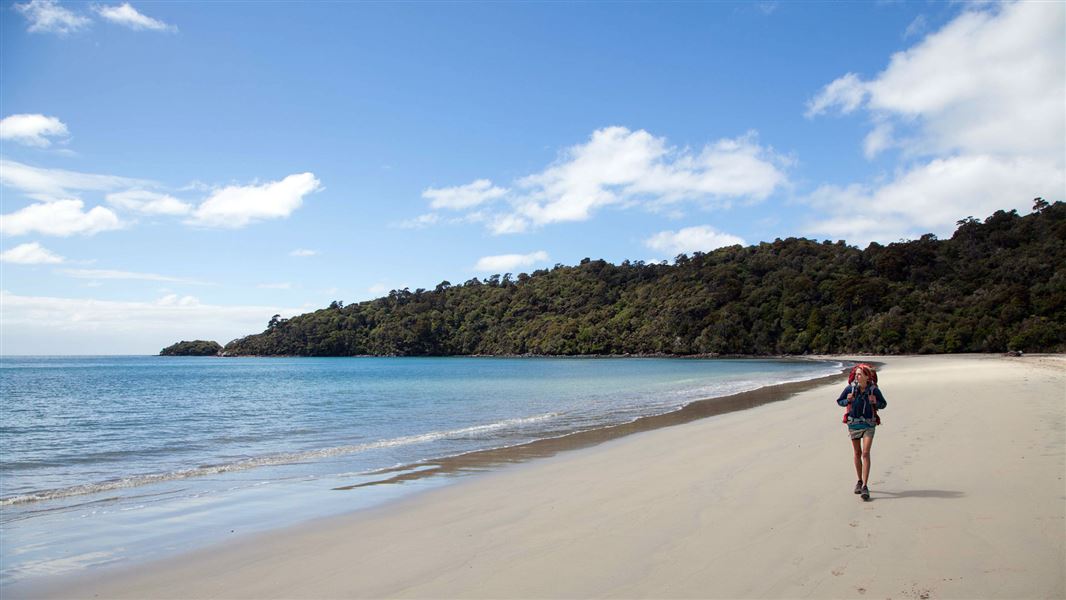Dog access
No dogs. Other pets on conservation land rules.
We need your help
The Southern dotterel/pukunui is in trouble. Donate to help save this species from extinction.
DOC and the New Zealand Nature Fund are working together to protect this species.
Visit the Rakiura National Park Visitor Centre for help with outdoor plans on Stewart Island/Rakiura, and to learn about the island's natural and cultural values.
Transport to the island is either a 20-minute flight from Invercargill Airport or a one-hour trip on the ferry from Bluff.
Trampers need to be prepared for southern weather which can turn wild, wet and windy at any time of the year.
There is always mud on the Northwest and Southern circuits and those attempting these tracks need to allow for flooding in certain areas during rainy periods.
A visit to the Rakiura National Park Visitor Centre in Oban is recommended before beginning any of the longer walks within Rakiura National Park, as weather and track conditions are constantly subject to change.
Weather forecast
 No unauthorised drone use in the national park
No unauthorised drone use in the national park
Unauthorised use of drones is prohibited. You must have a permit to fly a drone.
DOC does not generally approve permits to fly drones in this national park and we do not recommend you apply for one.
Stewart Island is remarkable for its almost complete cover of natural vegetation with rich birdlife. Read about nature in Rakiura National Park.
Rakiura National Park covers 157,000 ha, 85% of Stewart Island/Rakiura.
The National Park was established in 2002.
Excavations
Archaeological excavations have shown evidence of Maori habitation around Stewart Island/Rakiura from the 13th Century. Hunting camps or kaika were established at many coastal sites including Port William/Potirepo and Freshwater River, and were reached by outrigger canoe.
The first Europeans
The crew of Captain James Cook's ship Endeavour were the first Europeans to sight the island in 1770, but they mapped it as a cape connected to the South Island. Their reports of seals and whales drew the next wave of Europeans, and sealers established the first mixed race settlement, on Codfish Island in 1818.
Settlement at Port Pegasus/Pikihatiti
An attempted shipbuilding settlement at Port Pegasus/Pikihatiti in 1826 was the first of several ventures here including gold prospecting, tin mining and commercial fishing.
Land purchase and guardianship
Crown agents purchased the island from Rakiura Maori in 1864, but rights to harvest titi (sooty shearwater/muttonbird) were protected. Subsequent representations and agreements resulted in Rakiura Maori becoming kaitiaki (guardians) of over 10,000 hectares of Stewart Island land and the tïtï islands.
Activity at Port William/Potirepo
Port William was the site of the early Maori settlement of Pa Whakataka. Subsequently its sheltered harbour was used as a sealing and whaling base, was the site of unsuccessful gold prospecting, an oyster fishery and a brief attempted settlement of Shetland Islanders.
Paterson Inlet/Whaka a Te Wera
Development of large-scale industry began in 1861 with the opening of the first sawmills at Kaipipi in Paterson Inlet. A ready supply of timber helped establish shipbuilding, while fish-curing and the discovery of oyster beds prompted the growth of the island's fishing industry.
Ulva Island/Te Wharawhara in Paterson Inlet became the hub of the community through its post office built in 1872 and used until 1923. Over time, European settlement steadily concentrated around Oban, although there were pastoral farming ventures. Mason Bay was the site of the island's last major farm.
Island Hill Run and Homestead
Island Hill Run and Homestead is Stewart Island's longest running sheep station. It was established in 1879 and much remains of the original homestead complex. Find out about Island Hill Run and Homestead.
Today
The livelihoods of the island's 400 permanent residents are today based around cod fishing, paua and crayfish gathering, salmon and mussel farming and tourism. Today all residents live in Halfmoon Bay and other areas around Oban. Fishing, marine farming and tourism are the main industries of Stewart Island.
An island with many names
Rakiura is the Māori name for Stewart Island. It is translated as 'The Land of Glowing Skies' and probably refers as much to the night-time displays of Aurora Australis, the Southern Lights, as to the sunsets. The name may also refer to the story of ''Te Rakiura a Te Rakitamau' – the "deep blushing of Te Rakitamau", recalling his embarrassment on hearing that the woman he sought to marry was already engaged and his deepening blush when he asked after the woman's sister and heard she too was engaged.
The island is also known as Te Puka a te Waka a Maui, 'The Anchor of Māui Canoe' and a chain link sculpture at Lee Bay reflects this story. The island takes its more recent European name from William Stewart, an officer of the sealing vessel the Pegasus, who compiled the first detailed chart of the southern coast.
Rakiura National Park Visitor Centre
| Phone: | +64 3 219 0009 |
| Email: | stewartisland@doc.govt.nz |
| Address: | 15 Main Road Oban 9818 |
| Hours: | Visitor centre hours and services |

